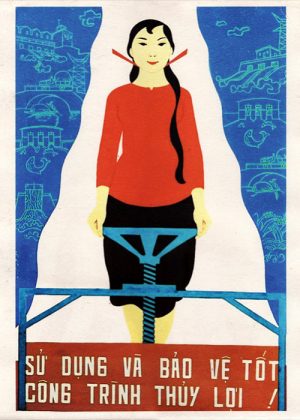Develop Family Breeding
Printed/hand-painted on rize paper.
Size “Small – Printed”: approx. 30 cm x 40 cm
Size “Large – Printed”: approx. 60 cm x 80 cm
Size “Large – Hand-painted”: approx. 60 cm x 80 cm (shipped free of charge by EMS – Express Mail Service)
Price range: $ 35 through $ 229
When the North and South were divided politically in 1954, they also adopted different economic ideologies: communist in the North and capitalist in the South. Destruction caused by the 1954-1875 Second Indochina War (commonly known as the Vietnam War) seriously strained Vietnam’s economy. Across Vietnam, the situation was worsened by the country’s 3 million military and civilian deaths and its later exodus of 2 million refugees, including tens of thousands of professionals, intellectuals, technicians, and skilled workers.
Between 1976 and 1986, for annual growth rates for industry, agriculture, and national income and aimed to integrate the North and the South, the Plan’s aims were not achieved: the economy remained dominated by small-scale production, low labor productivity, unemployment, material and technological shortfalls, and insufficient food and consumer goods. The more modest goals of the Third Five-Year Plan (1981–1885) were a compromise between ideological and pragmatic factions; they emphasized the development of agriculture and industry. Efforts were also made to decentralize planning and improve the managerial skills of government officials.
In 1986 Vietnam launched a political and economic renewal campaign (Doi Moi) that introduced reforms intended to facilitate the transition from a centrally planned economy to form of market socialism officially termed “Socialist-oriented market economy.” Doi Moi combined economic planning with free-market incentives and encouraged the establishment of private businesses in the production of consumer goods and foreign investment, including foreign-owned enterprises. By the late 1990s, the success of the business and agricultural reforms ushered in under Doi Moi was evident. More than 30,000 private businesses had been created, and the economy was growing at an annual rate of more than 7 percent, and poverty was nearly halved.
Additional information
| Size | Small (printed), Large (printed), Large (hand-painted) |
|---|





